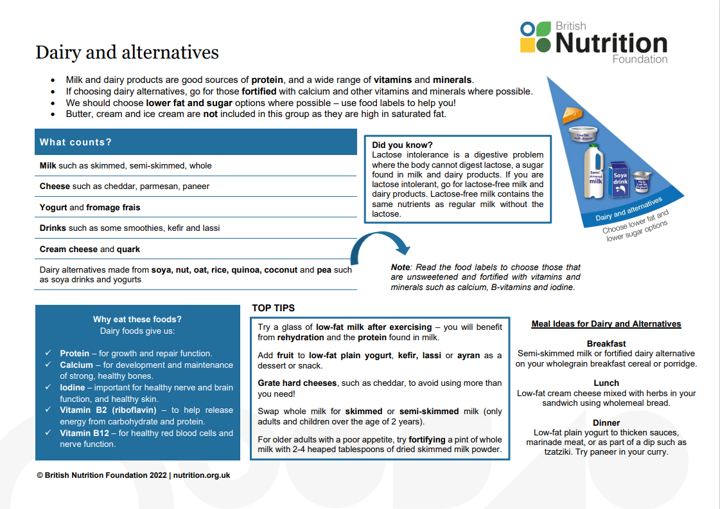Dairy and Dairy Alternatives
Dairy foods are a rich source of calcium, protein and vitamins which are essential for bone strength. By understanding the significance of dairy food consumption, individuals can make informed choices that promote a healthier lifestyle and ensure a well-rounded diet. Learn why dairy foods are important and how to include it within a healthy diet.
What is dairy?
Dairy products such as milk, cheese and yoghurt are great sources of protein and calcium and although the total fat content of dairy products can vary a lot, they can form part of a healthy balanced diet.
To make healthy dairy choices, look at the nutrition information on the label to check the amount of fat, including saturated fat, salt and sugar, in the dairy products you're choosing.

Milk
You can give children pasteurised whole or semi-skimmed cows' milk, or goats’ or sheep’s milk, as a main drink from the age of 1.
For older children and adults, it's a good idea to go for lower-fat milks because having too much saturated fat in your diet can lead to high cholesterol.
If you're trying to cut down on fat, try swapping to 1% fat or skimmed milk, as these still contain the important nutritional benefits of milk, but are lower in fat.
It’s ok to use 1% fat or skimmed milk when cooking for children over the age of 12 months. But do not give them as a main drink to children under the age of 5.
Cheese
Cheese can form part of a healthy, balanced diet, but it's good to keep track of how much you eat and how often as it can be high in saturated fat and salt.
Most cheeses, including brie, stilton, cheddar, Lancashire and double Gloucester, contain between 20g and 40g of fat per 100g.
Foods that contain more than 17.5g of fat per 100g are considered high in fat. Foods that contain 5g or more of saturates are considered high in saturated fats.
Some cheeses can also be high in salt. More than 1.5g salt per 100g is considered high. Eating too much salt can contribute to high blood pressure.
Try choosing reduced-fat hard cheeses, which usually have between 16g and 22g of fat per 100g.
Some cheeses are even lower in fat (3g of fat per 100g or less), including reduced-fat cottage cheese and quark.
If you're using cheese to flavour a dish or a sauce, you could try using a cheese that has a stronger flavour, such as mature cheddar or blue cheese, because then you'll need less.
But remember, it's recommended that "at risk" groups avoid certain cheeses, such as:
- infants and young children
- people over 65 years of age
- pregnant women
- those who have a long-term medical condition or weakened immune system
These cheeses include:
- mould-ripened soft cheeses like brie or camembert
- ripened goats' milk cheese like chèvre
- soft blue-veined cheese, such as roquefort
These cheeses may carry bacteria called listeria.
But these cheeses can be used as part of a cooked recipe as listeria is killed by cooking. Baked brie, for example, is a safer option.
